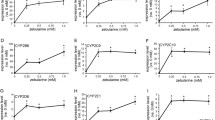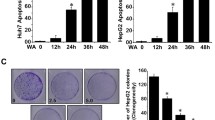Abstract
Hepatocyte tumor cell lines lack the expression or induction properties of major cytochrome P450 (CYP) enzymes compared to primary human hepatocytes. The Ras/Raf/MEK/ERK signaling cascade contributes to hepatocarcinogenesis, dedifferentiation and loss of hepatocyte drug metabolism in hepatocyte tumors. In the present study, we examined whether MEK1/2 inhibitors can restore the expression of CYP genes in hepatocarcinoma HepG2 cells. We found that U0126, a prototype dual MEK1/2 inhibitor, is a potent inducer of CYP3A4, CYP3A5 and CYP3A7 mRNA expression (>100-fold) in HepG2 cells and CYP3A4 mRNA expression in primary human hepatocytes. This U0126-mediated induction is sensitive to the transcriptional inhibitor actinomycin D and was not detected for CYP2B6 or MDR1 mRNA expression. In gene reporter assays, U0126 activates a CYP3A4 promoter luciferase reporter construct containing PXR response elements (PXREs), but not a construct containing mutated PXREs. Based on a ligand binding assay and the examination of a PXR mutant expressing an obstructed ligand binding pocket, we found that U0126 is a ligand of PXR. We also found that U0126 up-regulates the mRNA expression of the nuclear receptors HNF4α, CAR, VDR and PXR but abolishes small heterodimer partner (SHP) corepressor expression in HepG2 cells. The MEK1/2 inhibitors PD0325901 and PD184352, as well as dominant-negative MEK1 expression, also down-regulate SHP mRNA expression. In contrast, dominant-negative MEK1 expression does not significantly induce CYP3A4 gene in HepG2 cells. In conclusion, we found that U0126 is an atypical PXR ligand that via direct (binding and activation of PXR) and indirect (SHP dowregulation) mechanisms selectively restores CYP3A genes in HepG2 cells.







Similar content being viewed by others
Abbreviations
- CAR:
-
Constitutive androstane receptor
- CDCA:
-
Chenodeoxycholic acid
- CDK:
-
Cyclin-dependent kinase
- CYP:
-
Cytochrome P450
- DMEs:
-
Drug-metabolizing enzymes
- DN:
-
Dominant negative
- ERK1/2:
-
Extracellular signal-regulated kinases 1/2
- FXR:
-
Farnesoid X receptor
- HNF4α:
-
Hepatocyte nuclear factor-4 alpha
- LBD:
-
Ligand binding domain
- MAPK:
-
Mitogen-activated protein kinase
- MDR1:
-
Multi-drug resistance 1; ABCB1 gen; P-glycoprotein
- MEK1/2:
-
Mitogen-activated/extracellular signal-regulated kinase kinases 1/2
- NR:
-
Nuclear receptor
- PKA:
-
Cyclic AMP-dependent protein kinase
- PKC:
-
Protein kinase C
- PXR:
-
Pregnane X receptor
- PXRE:
-
Pregnane X receptor response element
- SHP:
-
Short/small heterodimer partner (N0B2)
- SRC1:
-
Steroid receptor coactivator-1
- UTR:
-
Untranslated region
References
Andrieux L, Langouet S, Fautrel A et al (2004) Aryl hydrocarbon receptor activation and cytochrome P450 1A induction by the mitogen-activated protein kinase inhibitor U0126 in hepatocytes. Mol Pharmacol 65(4):934–943. doi:10.1124/mol.65.4.934
Bachleda P, Dvorak Z (2008) Pharmacological inhibitors of JNK and ERK kinases SP600125 and U0126 are not appropriate tools for studies of drug metabolism because they activate aryl hydrocarbon receptor. Gen Physiol Biophys 27(2):143–145
Bertilsson G, Heidrich J, Svensson K et al (1998) Identification of a human nuclear receptor defines a new signaling pathway for CYP3A induction. Proc Natl Acad Sci USA 95(21):12208–12213
Blumberg B, Sabbagh W Jr, Juguilon H et al (1998) SXR, a novel steroid and xenobiotic-sensing nuclear receptor. Genes Dev 12(20):3195–3205
Braeuning A (2009) Regulation of cytochrome P450 expression by Ras- and β-catenin-dependent signaling. Curr Drug Metab 10(2):138–158
Castell JV, Jover R, Martinez-Jimenez CP, Gomez-Lechon MJ (2006) Hepatocyte cell lines: their use, scope and limitations in drug metabolism studies. Expert Opin Drug Metab Toxicol 2(2):183–212
De Luca A, Maiello MR, D’Alessio A, Pergameno M, Normanno N (2012) The RAS/RAF/MEK/ERK and the PI3K/AKT signalling pathways: role in cancer pathogenesis and implications for therapeutic approaches. Expert Opin Ther Targets 16(Suppl 2):S17–S27. doi:10.1517/14728222.2011.639361
Ding X, Staudinger JL (2005a) Induction of drug metabolism by forskolin: the role of the pregnane X receptor and the protein kinase a signal transduction pathway. J Pharmacol Exp Ther 312(2):849–856
Ding X, Staudinger JL (2005b) Repression of PXR-mediated induction of hepatic CYP3A gene expression by protein kinase C. Biochem Pharmacol 69(5):867–873
Donato MT, Lahoz A, Castell JV, Gomez-Lechon MJ (2008) Cell lines: a tool for in vitro drug metabolism studies. Curr Drug Metab 9(1):1–11
Dong H, Lin W, Wu J, Chen T (2010) Flavonoids activate pregnane X receptor-mediated CYP3A4 gene expression by inhibiting cyclin-dependent kinases in HepG2 liver carcinoma cells. BMC Biochem 11:23. doi:10.1186/1471-2091-11-23
Doricakova A, Novotna A, Vrzal R, Pavek P, Dvorak Z (2013) The role of residues T248, Y249 and T422 in the function of human pregnane X receptor. Arch Toxicol 87(2):291–301. doi:10.1007/s00204-012-0937-9
Fasinu P, Bouic PJ, Rosenkranz B (2012) Liver-based in vitro technologies for drug biotransformation studies—a review. Curr Drug Metab 13(2):215–224
Favata MF, Horiuchi KY, Manos EJ et al (1998) Identification of a novel inhibitor of mitogen-activated protein kinase kinase. J Biol Chem 273(29):18623–18632
Goodwin B, Hodgson E, Liddle C (1999) The orphan human pregnane X receptor mediates the transcriptional activation of CYP3A4 by rifampicin through a distal enhancer module. Mol Pharmacol 56(6):1329–1339
Goodwin B, Jones SA, Price RR et al (2000) A regulatory cascade of the nuclear receptors FXR, SHP-1, and LRH-1 represses bile acid biosynthesis. Mol Cell 6(3):517–526
Goodwin B, Moore LB, Stoltz CM, McKee DD, Kliewer SA (2001) Regulation of the human CYP2B6 gene by the nuclear pregnane X receptor. Mol Pharmacol 60(3):427–431
Haas S, Merkelbach-Bruse S, Justenhoven C, Brauch H, Fischer HP (2009) Expression of xenobiotic and steroid hormone metabolizing enzymes in hepatocellular tumors of the non-cirrhotic liver. Pathol Res Pract 205(10):716–725. doi:10.1016/j.prp.2009.06.003
Harmsen S, Koster AS, Beijnen JH, Schellens JH, Meijerman I (2008) Comparison of two immortalized human cell lines to study nuclear receptor-mediated CYP3A4 induction. Drug Metab Dispos 36(6):1166–1171. doi:10.1124/dmd.107.017335
Healan-Greenberg C, Waring JF, Kempf DJ, Blomme EA, Tirona RG, Kim RB (2008) A human immunodeficiency virus protease inhibitor is a novel functional inhibitor of human pregnane X receptor. Drug Metab Dispos 36(3):500–507. doi:10.1124/dmd.107.019547
Lee HC, Tian B, Sedivy JM, Wands JR, Kim M (2006) Loss of Raf kinase inhibitor protein promotes cell proliferation and migration of human hepatoma cells. Gastroenterology 131(4):1208–1217. doi:10.1053/j.gastro.2006.07.012
Lehmann JM, McKee DD, Watson MA, Willson TM, Moore JT, Kliewer SA (1998) The human orphan nuclear receptor PXR is activated by compounds that regulate CYP3A4 gene expression and cause drug interactions. J Clin Invest 102(5):1016–1023
Li T, Chiang JY (2006) Rifampicin induction of CYP3A4 requires pregnane X receptor cross talk with hepatocyte nuclear factor 4alpha and coactivators, and suppression of small heterodimer partner gene expression. Drug Metab Dispos 34(5):756–764
Lichti-Kaiser K, Brobst D, Xu C, Staudinger JL (2009a) A systematic analysis of predicted phosphorylation sites within the human pregnane X receptor protein. J Pharmacol Exp Ther 331(1):65–76
Lichti-Kaiser K, Xu C, Staudinger JL (2009b) Cyclic AMP-dependent protein kinase signaling modulates pregnane x receptor activity in a species-specific manner. J Biol Chem 284(11):6639–6649
Lin W, Wu J, Dong H, Bouck D, Zeng FY, Chen T (2008) Cyclin-dependent kinase 2 negatively regulates human pregnane X receptor-mediated CYP3A4 gene expression in HepG2 liver carcinoma cells. J Biol Chem 283(45):30650–30657. doi:10.1074/jbc.M806132200
Martinez-Jimenez CP, Jover R, Donato MT, Castell JV, Gomez-Lechon MJ (2007) Transcriptional regulation and expression of CYP3A4 in hepatocytes. Curr Drug Metab 8(2):185–194
Meloche S, Pouyssegur J (2007) The ERK1/2 mitogen-activated protein kinase pathway as a master regulator of the G1- to S-phase transition. Oncogene 26(22):3227–3239. doi:10.1038/sj.onc.1210414
Min L, He B, Hui L (2010) Mitogen-activated protein kinases in hepatocellular carcinoma development. Semin Cancer Biol. doi:10.1016/j.semcancer.2010.10.011
Min L, He B, Hui L (2011) Mitogen-activated protein kinases in hepatocellular carcinoma development. Semin Cancer Biol 21(1):10–20. doi:10.1016/j.semcancer.2010.10.011
Novotna A, Doricakova A, Vrzal R, Pavek P, Dvorak Z (2011) Construction and characterization of hepatocyte nuclear factor HNF4alpha1 over-expressing cell line derived from human hepatoma HepG2 cells. Eur J Pharmacol 669(1–3):45–50. doi:10.1016/j.ejphar.2011.07.049
Osabe M, Sugatani J, Takemura A et al (2009) Up-regulation of CAR expression through Elk-1 in HepG2 and SW480 cells by serum starvation stress. FEBS Lett 583(5):885–889. doi:10.1016/j.febslet.2009.01.051
Ourlin JC, Lasserre F, Pineau T et al (2003) The small heterodimer partner interacts with the pregnane X receptor and represses its transcriptional activity. Mol Endocrinol 17(9):1693–1703. doi:10.1210/me.2002-0383
Pan YZ, Gao W, Yu AM (2009) MicroRNAs regulate CYP3A4 expression via direct and indirect targeting. Drug Metab Dispos 37(10):2112–2117. doi:10.1124/dmd.109.027680
Pavek P, Pospechova K, Svecova L et al (2010) Intestinal cell-specific vitamin D receptor (VDR)-mediated transcriptional regulation of CYP3A4 gene. Biochem Pharmacol 79(2):277–287. doi:10.1016/j.bcp.2009.08.017
Pavek P, Stejskalova L, Krausova L, Bitman M, Vrzal R, Dvorak Z (2012) Rifampicin does not significantly affect the expression of small heterodimer partner in primary human hepatocytes. Front Pharmacol 3:1. doi:10.3389/fphar.2012.00001
Plant N (2007) The human cytochrome P450 sub-family: transcriptional regulation, inter-individual variation and interaction networks. Biochim Biophys Acta 1770(3):478–488. doi:10.1016/j.bbagen.2006.09.024
Pondugula SR, Brimer-Cline C, Wu J, Schuetz EG, Tyagi RK, Chen T (2009) A phosphomimetic mutation at threonine-57 abolishes transactivation activity and alters nuclear localization pattern of human pregnane X receptor. Drug Metab Dispos 37(4):719–730
Pospechova K, Rozehnal V, Stejskalova L et al (2009) Expression and activity of vitamin D receptor in the human placenta and in choriocarcinoma BeWo and JEG-3 cell lines. Mol Cell Endocrinol 299(2):178–187. doi:10.1016/j.mce.2008.12.003
Rochette-Egly C (2003) Nuclear receptors: integration of multiple signalling pathways through phosphorylation. Cell Signal 15(4):355–366
Rodriguez-Antona C, Donato MT, Boobis A et al (2002) Cytochrome P450 expression in human hepatocytes and hepatoma cell lines: molecular mechanisms that determine lower expression in cultured cells. Xenobiotica 32(6):505–520. doi:10.1080/00498250210128675
Rulcova A, Prokopova I, Krausova L et al (2010) Stereoselective interactions of warfarin enantiomers with the pregnane X nuclear receptor in gene regulation of major drug-metabolizing cytochrome P450 enzymes. J Thromb Haemost 8(12):2708–2717
Shaul YD, Seger R (2007) The MEK/ERK cascade: from signaling specificity to diverse functions. Biochim Biophys Acta 1773(8):1213–1226. doi:10.1016/j.bbamcr.2006.10.005
Shimada T, Yamazaki H, Mimura M, Inui Y, Guengerich FP (1994) Interindividual variations in human liver cytochrome P-450 enzymes involved in the oxidation of drugs, carcinogens and toxic chemicals: studies with liver microsomes of 30 Japanese and 30 Caucasians. J Pharmacol Exp Ther 270(1):414–423
Smutny T, Mani S, Pavek P (2013) Post-translational and post-transcriptional modifications of pregnane X receptor (PXR) in regulation of the cytochrome P450 superfamily. Curr Drug Metab 14(10):1059–1069
Svecova L, Vrzal R, Burysek L et al (2008) Azole antimycotics differentially affect rifampicin-induced pregnane X receptor-mediated CYP3A4 gene expression. Drug Metab Dispos 36(2):339–348. doi:10.1124/dmd.107.018341
Takeshita A, Taguchi M, Koibuchi N, Ozawa Y (2002) Putative role of the orphan nuclear receptor SXR (steroid and xenobiotic receptor) in the mechanism of CYP3A4 inhibition by xenobiotics. J Biol Chem 277(36):32453–32458
Vrzal R, Stejskalova L, Monostory K et al (2009) Dexamethasone controls aryl hydrocarbon receptor (AhR)-mediated CYP1A1 and CYP1A2 expression and activity in primary cultures of human hepatocytes. Chem Biol Interact 179(2–3):288–296
Wang H, Faucette S, Sueyoshi T et al (2003) A novel distal enhancer module regulated by pregnane X receptor/constitutive androstane receptor is essential for the maximal induction of CYP2B6 gene expression. J Biol Chem 278(16):14146–14152. doi:10.1074/jbc.M212482200
Wang H, Huang H, Li H et al (2007) Activated pregnenolone X-receptor is a target for ketoconazole and its analogs. Clin Cancer Res 13(8):2488–2495
Wiesenauer CA, Yip-Schneider MT, Wang Y, Schmidt CM (2004) Multiple anticancer effects of blocking MEK-ERK signaling in hepatocellular carcinoma. J Am Coll Surg 198(3):410–421. doi:10.1016/j.jamcollsurg.2003.10.004
Wilkinson MG, Millar JB (2000) Control of the eukaryotic cell cycle by MAP kinase signaling pathways. FASEB J 14(14):2147–2157. doi:10.1096/fj.00-0102rev
Zhou C, Poulton EJ, Grun F et al (2007) The dietary isothiocyanate sulforaphane is an antagonist of the human steroid and xenobiotic nuclear receptor. Mol Pharmacol 71(1):220–229
Acknowledgments
This research has been supported by the Czech Scientific Agency GACR303/12/0472 (to P.P.) and by SVV 170/50/33904-3 Project.
Conflict of interest
None.
Author information
Authors and Affiliations
Corresponding author
Rights and permissions
About this article
Cite this article
Smutny, T., Bitman, M., Urban, M. et al. U0126, a mitogen-activated protein kinase kinase 1 and 2 (MEK1 and 2) inhibitor, selectively up-regulates main isoforms of CYP3A subfamily via a pregnane X receptor (PXR) in HepG2 cells. Arch Toxicol 88, 2243–2259 (2014). https://doi.org/10.1007/s00204-014-1254-2
Received:
Accepted:
Published:
Issue Date:
DOI: https://doi.org/10.1007/s00204-014-1254-2




